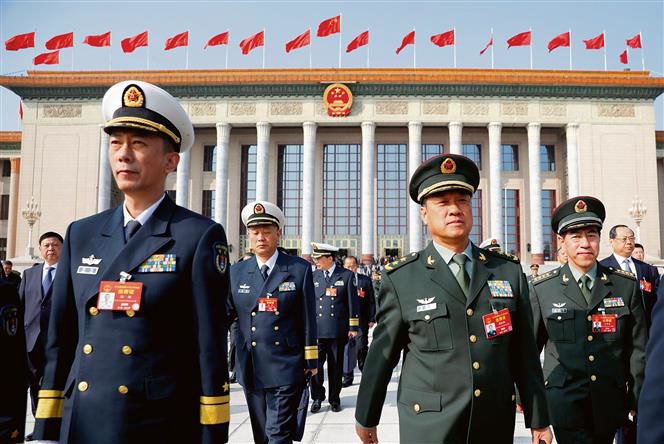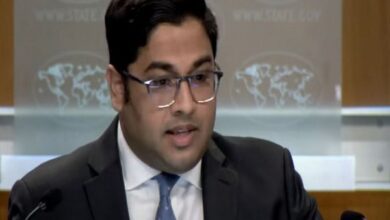Xi is eager to increase military readiness for combat
The Chinese People’s Political Consultative Conference (CPPCC), China’s equivalent of a parliament, and the National People’s Congress (NPC), which is composed of approximately 6,000 CCP members and high-ranking government officials, convened in Beijing recently for a week of plenary sessions.

During the NPC meeting held from March 4–11, it was evident that President Xi Jinping had strengthened his position as China’s top leader and put the CCP’s seal of approval on the government. It also reiterated China’s aspirations to dominate the world. But the financial issues were hardly mentioned.
Premier Li Qiang delivered the 40-page Government Work Report aloud on the first day, which included glowing references to President Xi, as has been required since the 18th Party Congress in 2012. Premier Li did, however, give him extra recognition this year. Li declared: “General Secretary Xi Jinping, who is leading the way, deserves all of our accomplishments in 2023.”
Beijing’s primary priority, security, was highlighted 28 times in the report—a three-fold increase over the previous year’s report. Speaking to officials from the federal and local governments, Li emphasized the need of “promoting stability through progress” and said that “stability is of overall importance, as it is the basis for everything we do.” More policies that support maintaining stability in employment, economic growth, and expectations should be adopted by all communities and government agencies. This focus on security and stability was also evident in the Supreme People’s Court report, which was released on March 8.
It reported a 29.5% rise in the number of cases that were successfully resolved. It’s interesting that it said “0.04% of the other cases,” which are situations that “harm national security, harm defense interests.” Put otherwise, among the 70,520 cases pertaining to national security and defense that the Supreme People’s Court heard in 2023, less than 1 in 20,000 Chinese defendants faced charges of subversion!
The country’s defense budget had single-digit growth for the ninth year in a row in 2024, when it climbed by 7.2%, or 1.67 trillion yuan ($231.4 billion). Since Xi entered office in 2013, this funding has increased. This rise, despite a declining GDP growth rate, demonstrates China’s determination to “recover” its “lost” regions and to construct a cutting-edge, world-class army.
Notable is the renewed focus on developing the navy and cutting-edge technologies. Xi “emphasized that the strategic capabilities in emerging fields are crucial components of the national strategic system and capabilities, which are related to the high-quality development of China’s economy and society, national security, and the initiative of military struggle” in remarks made to PLA representatives on March 7 during the plenary sessions of the NPC and CPPCC. In order to effectively integrate and stimulate both new combat troops and production forces, he emphasized the need for doing so.
In addition to highlighting the need for “integrating preparation for maritime military warfare, safeguarding maritime rights, and developing the maritime economy,” Xi emphasized the need to strengthen strategic capabilities in developing domains. China will soon reveal its fourth aircraft carrier, according to Yuan Huazhi, Political Commissar of the PLA Navy and NPC Deputy, who made this announcement to the Hong Kong Commercial Daily on March 5. He said that China’s aircraft carrier technology was advancing without any difficulties. Ample funding for the navy will be guaranteed by the selection of Gen. Dong Jun, a PLA Navy commander and submariner, as Defense Minister.
Xi also highlighted strengthening the capacity to protect national network security and developing a network space defense system. He urged bolstering the coordinated execution of important scientific and technological initiatives, encouraging autonomous and original inventions, and cultivating a thriving ecosystem for innovation—alluding to the merging of the civil and military.
The State Council’s chairman of the state-owned Assets Supervision and Administration Commission, Zhang Yuzhuo, said that central state-owned enterprises’ (SOEs’) investment in strategically important developing sectors rose by 32.1% in 2023 and is expected to continue growing. He said that “particularly brain-like intelligence, quantum information, and controlled nuclear fusion” will be the main areas of concentration.
The Government Work Report aimed to cover up China’s economic issues, as was to be expected. However, it showed the nation’s economic problems by predicting a GDP growth rate of 5%, which was the same as the year before, and expecting an inflation rate of 3%, which was also the same as the previous year.
The government’s unwillingness to establish a target it cannot meet or a realistically low one that would further erode trust was shown by the growth rate of 5%, which remained constant. China does not have the same advantage as it had in the previous year, when the country’s rapid withdrawal from the “zero Covid” policy led to a sharp increase in economic activity in the first half of the year.
Furthermore, the National Statistics Bureau of China indicates that the economy is sliding toward deflation even though the government estimates inflation at about 3%. The CCP’s inability to convene the Third Plenum, which sets the nation’s economic objectives, as scheduled in October or November of last year shows internal divisions within the party.
Xi and the CCP’s dominant position were reaffirmed and reinforced during the NPC plenary session. It said that manufacturing would continue to be significant and that maintaining China’s place in the global supply chain will be a top priority. However, no economic stimulus measures were declared for China.
China’s private business owners would have been dissatisfied with the lack of incentives and the SOEs’ clearly preferred position given by the Politburo. What was significant was Xi’s focus on using cutting-edge technology to improve the PLA Navy’s capabilities and fortifying the armed forces for multi-dimensional combat (land, air, cyber, space, and sea).







